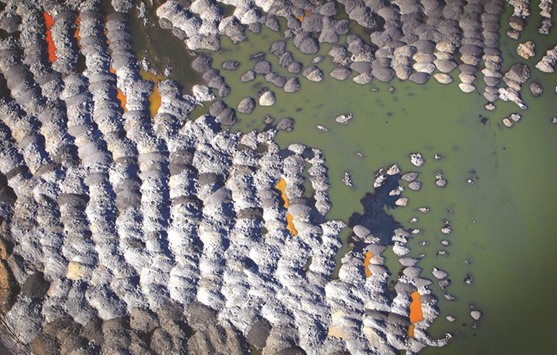One year after massive wildfires swept through Alberta province in Canada’s worst natural disaster in history, the future of the oil sands — which contain a third of the world’s oil reserves — remains bleak.
Persistently low oil prices have forced companies to cut costs, and several have gone as far as to stop processing the region’s heavy crude and bitumen, which is more expensive and harder to extract than typical light crude.
“The wildfire magnified the problem here,” said Bilal Abbas, an Shell subcontractor who fears for his job after the oil company recently announced it would halt local production.
The 2016 wildfires stopped nearly all oil sands extraction and refining for an entire month, slashing production by more than a million barrels of oil a day, or 0.4 percentage points of Canada’s gross domestic product, according to government statistics.
It brought to a standstill an oil rush that had started a decade earlier, when energy conglomerates including ExxonMobil, Shell, Statoil and Total bought up stakes while oil prices topped $100 a barrel.
At the heart of the oil patch, the city of Fort McMurray’s population exploded to nearly 100,000 as people from around the world came to the remote northern region hoping to make big bucks.
However, this northern Eldorado would give way to gloom in 2014, when the oil bubble burst and Alberta was plunged into a long recession from which it is only now beginning to emerge.
“The companies have cut back and have announced a lot of layoffs,” Abbas said. “The morale in Fort McMurray has taken a dip, which I feel got amplified by the wildfire.”
Canadian Association of Petroleum Producers chief Tim McMillan lays the blame for the oil crash squarely on new fracking technologies that have enabled the United States to boost oil and gas production by exploiting shale deposits.
“During the Obama years, innovation helped American oil production jump by 4.4mn barrels a day,” he said. “That’s more than all the oil we produce in Canada.”
The world was “awash in low-cost hydrocarbons” as a result, he said, and the price of light crude oil plunged to around $50 a barrel.
The price of Canadian oil, already discounted thanks to its lack of global market access, fell further.
Although Canada produces some 3.6mn barrels of oil per day, making it the world’s sixth-largest producer, it sells most of its output to the neighbouring United States, whose energy sector is meshed with Canada’s industry. “Our number-one customer is our number-one competitor,” McMillan said. “And under the Trump administration, the competition (from the United States) is only going to get tougher.”
Following in the footsteps of Statoil and Shell, other companies have partly or completely pulled out of the oil sands in the past year, and — like ConocoPhillips and Marathon Oil — headed for greener pastures such as the North Dakota shale fields in the United States.
The major Canadian firms Canadian Natural Resources and Cenovus have spent more than $30bn to buy their assets.
They are determined to increase oil sands output after the Canadian and US administrations recently approved new pipelines to the United States and coastal ports.
But they face an uphill battle because of environmental regulations.
The sector produces a quarter of Canada’s total CO2 emissions and Prime Minister Justin Trudeau has pledged to slash the country’s greenhouse gas pollution by 30% from 2005 levels by 2030.
Since the start of the year, the sector must also factor in a C$30 ($22) per tonne carbon tax imposed by the Alberta government.
Fort McMurray Mayor Melissa Blake acknowledges the daunting reality: “I don’t think you’re going to see new growth in the oil sands.”

An oil sands mine is seen in this aerial photograph taken near Fort McMurray, Alberta. The 2016 wildfires brought to a standstill an oil rush that had started a decade earlier, when energy conglomerates including ExxonMobil, Shell, Statoil and Total bought up stakes while oil prices topped $100 a barrel.


